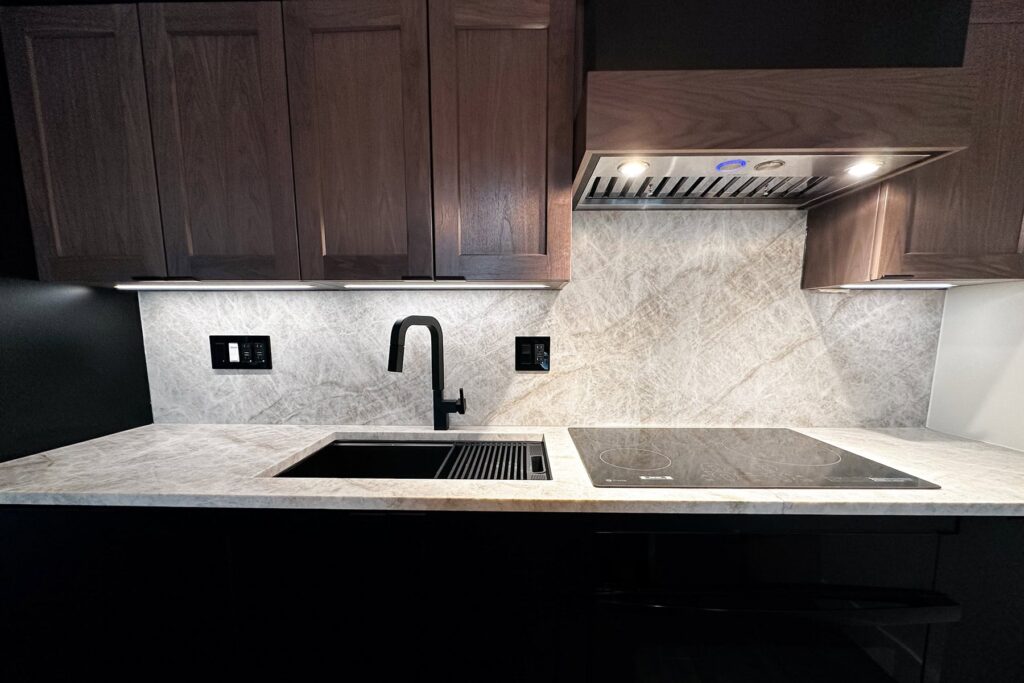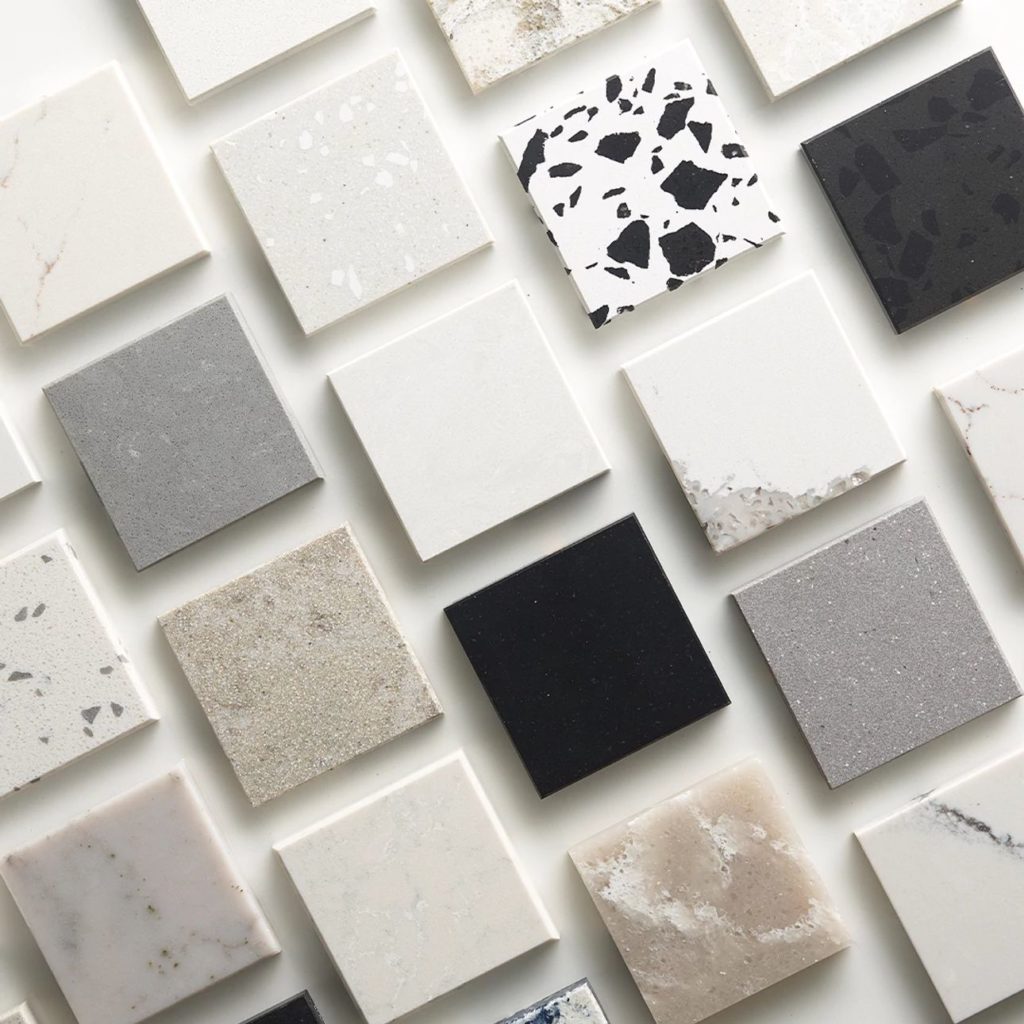As a kitchen & bath design center, you can guarantee that we’ve come across a lot of different designs for remodeling. We’ve seen hundreds of different stone combinations with all sorts of shapes and sizes. While larger slabs are trending for interior design, there’s a lot that can be done with tiles as well. We’ve seen some gorgeous rooms styled with tile and think that there are so many possibilities with the slab’s more petite cousin.
A tile is defined as a manufactured piece of hard-wearing material that is generally used for roofing, flooring, walls, or other surfaces like tabletops and fireplaces. The word is derived from the French word tuile, which is, in turn, from the Latin word tegula, meaning a roof tile composed of fired clay. Common materials of tile include ceramic, stone, metal, baked clay, and glass. The tiles you more often see are probably made of ceramic, but stone tiles are becoming more and more popular. We should know – we have a whole section of our warehouse dedicated to marble, onyx, granite, and slate tiles!
So, where exactly do tiles come from? The earliest evidence that we know of comes from the discovery of glazed bricks in the Elamite Temple at Chogha Zanbil back in the 13th century. We know this location to be present-day southwestern Iran. Glazed and colored bricks were used to make low reliefs in Ancient Mesopotamia. The use of sun-dried bricks was the main method of building in areas where river mud was found in abundance. This is most likely due to the scarcity of stone; there was more incentive to develop a way to make bricks from other materials to use as an alternative. Fired bricks began to be used as an outer layer for important buildings made out of sun-dried bricks to strengthen and protect the walls. These buildings include temples, palaces, city walls, and gates.
Around the 10th-11th century, tile started being used for more decorative purposes. Early Islamic mosaics in Iran consisted mainly of geometric decorations in mosques and mausoleums using glazed brick. Persian tilework really took off when the moraq technique was used to cover interior and exterior surfaces. This technique involved taking single-color tiles and cutting them into small geometric pieces, then assembling by pouring liquid plaster between them. Once the plaster hardened, the tiles would be used on the walls of buildings and the surfaces of domes. The most sophisticated tilework would be placed in the mihrabs of mosques, given that these are the focal points for prayer. This tradition spread through the Islamic world during the 16th-17th century. Palaces, public buildings, mosques, and türbe (“tomb”) mausoleums were heavily decorated with large, brightly colored patterns, which were typically floral motifs.
Further west in Medieval Europe, Medieval Europe made considerable use of painted tiles, using them to depict very elaborate stories. Some of the tiles they used were encaustic, meaning they were made of multiple colors of clay, shaped and baked together to form a pattern. The difference here is that the pattern ran through the thickness of the tile and would not wear away. Some stories depicted included religious and secular stories since Christianity dominated during this time. Medieval letter tiles (one letter ceramic tiles) were used to create Christian inscriptions on church floors.
During the Victorian period, technology became involved with crafting tiles. Patterned tiles were now mass-produced by machine. These tiles were reliably level for floors and inexpensive to produce, making them ideal for public buildings such as churches and schools. They were also great for domestic spaces like the hallways of homes and bathrooms. Encaustic tiles were often used since they were more durable, but wall tiles were also used in 20th-century bathrooms. In the 1980s, ceramic tile was widely used due to its wide variety of aesthetic choices. Tile countertops were a popular option because they were cost-effective and easy to install (and still are!). While many homes still have tile countertops, they are installed much less today. Tile itself is easy to clean; however, the grout in between can stain easily and harbor bacteria, if not properly dealt with.
In today’s times, we find that tiles can be very decorative, but also very practical. You might not have given it much thought before, but there’s a reason the roof of your home is laid out with dozens of tiles. These tiles are designed mainly to keep out rain and heat, and are traditionally made from locally available materials like clay, granite, terracotta, or slate. Some more modern roofing materials include concrete, glass, and plastic. We’ve also seen a large number of roof tile shapes evolve. These include Spanish roof tiles, which have more of an “S” shape; Mission roof tiles, which have separate barrels installed to form alternating concave and rounded shapes; Flat shingle roof tiles; Interlocking roof tiles, which include channels on one or two sides of the tile to interlock and create a connection with other tiles; Shake roof tiles, which look similar to flat shingle tiles but have more texture; Scalloped roof tiles; French roof tiles, which includes two flutes on the surface of the tile; and finally, graduated & tapered roof tiles, which are special tiles primarily for round towers or domed shaped roof sections.
Another example of tiling for practical purposes would be flooring tiles. These tiles are commonly made of ceramic or stone but can include glass tiles for floors as well. These tiles are typically set into mortar (a workable paste that hardens to bind building blocks) consisting of sand, cement, and a latex additive. Granite and marble tiles are sawn on both sides and then polished on the top surface so that they have a uniform thickness. Other natural stone tiles, like slate, are typically split on the top surface so that the thickness of the tile varies slightly. This helps the tile to become more slip-resistant when wet. Some stone tiles like polished granite, marble, or travertine are very slippery when wet, so it’s a good idea to sandblast or hone the surface to make it more stable. Natural stone tiles must be sealed and resealed with a sealant every so often to prevent staining from spilled liquids. This, of course, depends on how porous the stone is. Marble may need to be resealed more often than granite. However, because of the intricate patterns in natural stone, small amounts of dirt on these floor tiles are not obvious. At Stone City, we like to emphasize that there will be variations in color and pattern from one batch of tiles to another, even if they are within the same batch. While natural stone is unpredictable in aesthetic, handcrafted ceramic tiles are more predictable with their looks. Ceramic tiles are very durable but do typically have a glazed upper surface that should be minded. When the glaze becomes scratched or pitted, the tiles can look worn. However, they are more low maintenance than natural stone tiles; while natural stone needs to be sealed all over, ceramic tiles only need their grout lines sealed. Ceramic tiles are also much easier to clean since they are stain-resistant.
As you can see, tiles have an unexpectedly rich history and a plethora of uses. This only begins to scratch the surface of information. The next blog post will discuss more influential tiles in further detail, so hold tight until next week!

